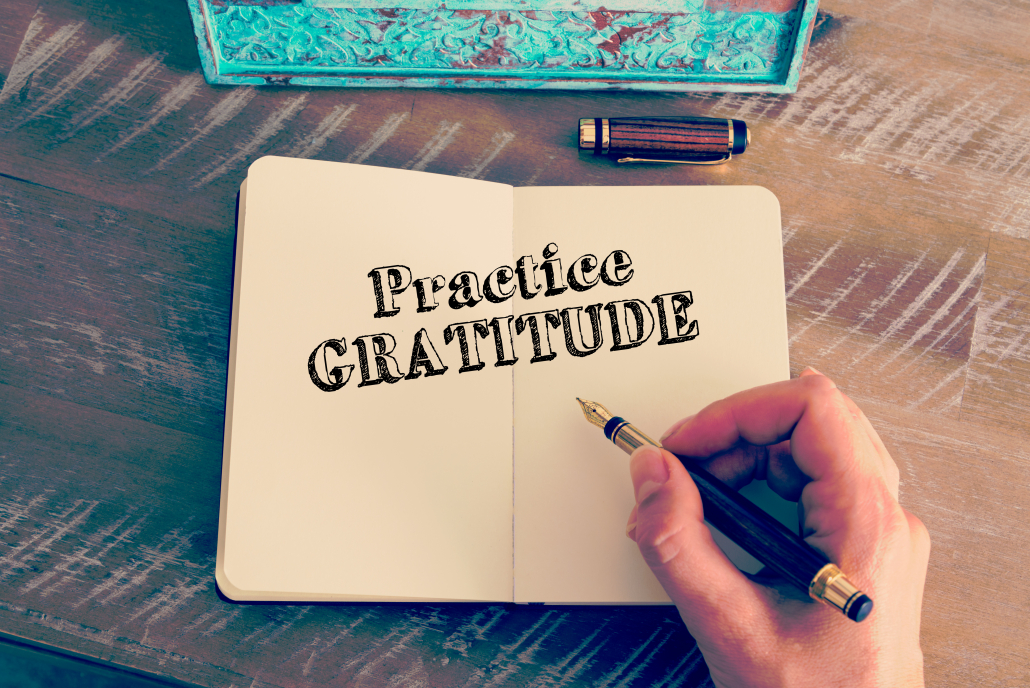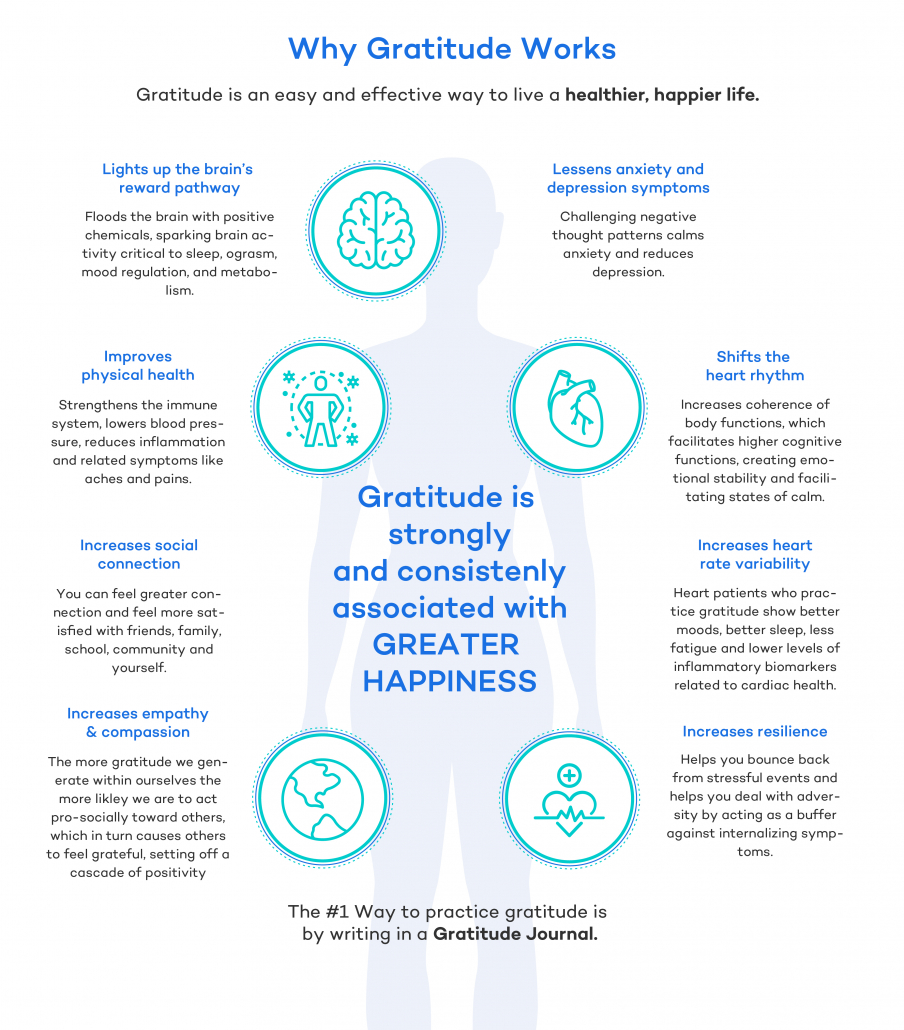We include products in articles we think are useful for our readers. If you buy products or services through links on our website, we may earn a small commission.
How to Practice Gratitude: 3 Proven Techniques

Table of Contents
Learning how to practice gratitude has long-term positive effects on our lives. It has been shown to help our bodies stay healthy, balance our minds, and improve our relationships. After consistent gratitude practice, many of these benefits are reflected in changes to the structure of the brain.
Gratitude is a state of thankfulness and appreciation that all people are capable of feeling.
But gratitude doesn’t just feel good. It’s good for you.
Learning how to practice gratitude:
- increases positive emotions.
- strengthens your immune system.
- improves your sleep.
- increases your self-esteem.
- leads to more and better relationships.
- helps you stick with self-care routines like yoga and healthy eating.
- increases productivity and satisfaction in the workplace.

Getting Started
For many people new to practicing gratitude, it can feel unnatural and challenging. That’s because the negative parts of our lives–the fears, resentments, and disappointments–can take up more of our attention than the positive parts.
Modern life is hyper-competitive, and we’re told that we can’t be happy until we attain external things like wealth, status, and material objects. This leads to shame and low-self esteem, which can make you feel like you’re not worth the effort.
Thankfully, we have gratitude practices that refocus our attention away from what we think we lack, and towards an appreciation of what we already have.
Give Gratitude Some Time
For many people practicing gratitude can feel really good the moment you begin. Yet the long-term positive benefits accrue over time. Hence the word “practice”.
And it’s worth it. When practicing gratitude the mental health benefits have been shown to increase in the long term, rather than plateau and decline, as is the case for many other positive activities.
So give gratitude some time, and it can give you back a completely different way of relating to life.
How to Practice Gratitude Journaling
A standard practice in hundreds of gratitude studies, all you need is a journal, something to write with, or a dedicated file on your computer or smartphone.
3×3 Approach
You can begin with what’s called a 3×3 approach. This means that 3 days out of each week you write down three things you are grateful for in your life.
Starting out this way can protect you from getting down on yourself if you forget a day, or when life gets too busy.
As you begin to feel the momentum of gratitude building, you can increase the frequency of your journaling by a day or two. If you find yourself journaling every day while still finding more things to be grateful for each day, bravo! If not, that’s totally fine too.
Just as there’s no right or wrong frequency for gratitude journaling, no one can tell you what you should or shouldn’t be grateful for. The things we feel grateful for are unique to each of us, and they change from day to day.
Another added benefit of gratitude journaling is that it doubles as a daily diary that you can look back on in order to gain deeper insights into the themes and patterns appearing in your life. All through the nurturing and inspiring lens of gratitude.
Journaling Prompts
Having trouble getting started? These prompts can help you learn how to practice gratitude. But remember it’s ok if you don’t have answers to any of these questions, they’re just here to help get the juices flowing.
- What is there about a challenge you are experiencing right now that you can be thankful for?
- Who has done something to help you this week for which you are grateful? How can you thank them?
- What was the last great experience you had in nature?
- What was the most delicious ketogenic meal you’ve had this last week?
- How is your life today different than it was one year ago, and what about these changes are you grateful for?
- List three people in your life you find it difficult to get along with and write down a positive quality you see in each of them that you are grateful for.
- What is something new you’ve learned this week that you are grateful for?
- What music did you listen to this week that you are grateful to have heard?
- Something that made you smile today?
- Something funny that made you laugh?
- A favorite place you’ve visited?
- A modern invention that you rely on and are grateful for?
How to Practice Guided Gratitude Meditations
Guided gratitude meditations are another proven way to activate the power of gratitude. But before jumping into the practice, you can make sure you get the most out of it by setting the “container”– a consistent and intentional time, space, and mindset.
Setting the Container
When people ask how much meditation they need to truly feel its effects, researchers liken it to other activities we use to keep our body healthy. Your body responds optimally to a few hours of intentional activity each week.
The same goes for your mind. This translates to around 20 minutes each day. But you can keep it fresh by experimenting with the focus of your meditation–not every meditation has to be explicitly on gratitude.
It’s also helpful to practice for at least 20-minute at a time. This is based on the fact that our brains take around 20 minutes to become fully focused.
Same time, Same place
Humans are creatures of habit. When it comes to practicing meditation, we can use this to our advantage. By choosing the same time and place to meditate each day, we are priming our bodies and brains to drop into focus more quickly and deeply.
Find a place that feels naturally comfortable, but sometimes the only space we have is our car. Sometimes you just have to take the space wherever you can get it.
Zero Judgment
There is no right or wrong way to meditate. There are no grades. Are you showing up and giving it your best effort? That’s all that matters.
6 Stage Gratitude Meditation
- Settle into a relaxed posture. You can close your eyes if you want, but you don’t have to. Inhale for 5 seconds, hold for 5 seconds, release your breath slowly for 10 seconds. Repeat this sequence of breathing 3 times.
- Think about something in your life you are very grateful for. Notice any sensations that arise in your body. Inhale for 5 seconds, hold for 5 seconds, release your breath slowly for 10 seconds.
- Notice any sensations in your immediate surroundings. What do you smell, taste, touch, see, hear? Say to yourself: “For this, I am grateful.” Inhale for 5 seconds, hold for 5 seconds, release your breath slowly for 10 seconds.
- Next, call into your mind an image of someone who you effortlessly feel love for—a close friend, a family member, your partner. Say to yourself, “For this, I am grateful.” Inhale for 5 seconds, hold for 5 seconds, release your breath slowly for 10 seconds.
- Next, turn your attention to yourself: You are a unique being. You are able to feel a rich array of emotions; you can communicate with others, you have an imagination that allows you to learn from the past and prepare for the future. You have the resolve to focus right here and now on the gift of being you at this very moment. Maybe you have made it through hardship that has helped you to grow and given your strength. Say to yourself: “For this, I am grateful.” Inhale for 5 seconds, hold for 5 seconds, release your breath slowly for 10 seconds.
- Finally, rest in the realization that your life is a gift. You are resilient in the face of challenge and gracious in the face of success. Say to yourself: “For this, I am grateful.” Inhale for 5 seconds, hold for 5 seconds, release your breath slowly for 10 seconds.
How to Practice Expressing Gratitude
Expressing gratitude is more than courtesy or good manners. When we make expressing gratitude a practice we are showing our authentic appreciation. This activates the two-step process of true gratitude: noticing something good in your life, and genuinely appreciating the people and circumstances outside of yourself that helped this good thing happen to you.
Show your appreciation to someone who did something that made you feel good.
You can express gratitude by saying:
- “It was really kind of you to…”
- “It was a really big help for me when you…”
- “You did me a big favor that time when…”
- “Thank you for taking the time to listen when…”
- “I really appreciated that you taught me…”
- “Thank you for being there when….”
You can even turn this into a letter-writing practice. In one study leading gratitude researchers had 411 participants write a letter to someone they felt appreciation for and personally deliver and read it to them.
Nearly all participants reported large increases in happiness. And better yet, their happiness increased as time went on.
The Outlook
These techniques can help you establish an attitude of gratitude that has been proven to benefit mind, body, careers, and relationships.
When learning how to practice gratitude, it takes time to reap the full rewards, so consistency is key.
However, feeling and expressing authentic gratitude isn’t dependent on these practices. As you go through your day see how many times you can notice that someone does something kind for you, and thank them for it!
Maybe it’s your partner who cooked you dinner. A simple, “wow, thank you for making me dinner, that’s really kind of you,” can create positive feelings that ripple out into every other part of life, while strengthening the periods of focused practice.












